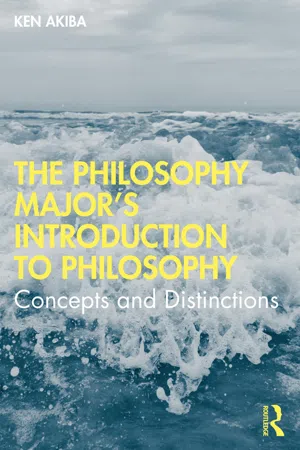
- 190 pages
- English
- ePUB (mobile friendly)
- Available on iOS & Android
About This Book
Many philosophy majors are shocked by the gap between the relative ease of lower-level philosophy courses and the difficulty of upper-division courses. This book serves as a necessary bridge to upper-level study in philosophy by offering rigorous but concise and accessible accounts of basic concepts and distinctions that are used throughout the discipline. It serves as a valuable advanced introduction to any undergraduate who is moving into upper-level courses in philosophy.
While lower-level introductions to philosophy usually deal with popular topics accessible to the general student (such as contemporary moral issues, free will, and personal identity) in a piecemeal fashion, The Philosophy Major's Introduction to Philosophy offers coverage of important general philosophical concepts, tools, and devices that may be used for a long time to come in various philosophical areas. The volume is helpfully divided between a focus on the relation between language and the world in the first three chapters and coverage of mental content in the final two chapters, but builds a coherent narrative from start to finish. It also provides ample study questions and helpful signposts throughout, making it a must-have for any student attempting to engage fully with the problems and arguments in philosophy.
Key Features
-
- Integrates topics from various areas of philosophy, such as philosophy of language, metaphysics, epistemology, ethics, and philosophical logic
-
- Provides descriptions of logico-mathematical tools necessary for philosophical studies, such as propositional logic, predicate logic, modal logic, set theory, mereology, and mathematical functions
-
- Makes connections with modern philosophy, including discussions of Descartes's skepticism and dualism, Locke's theory of personal identity, Hume's theory of causation, and Kant's synthetic a priori
-
- Includes well-known entertaining puzzles and thought experiments such as the Ship of Theseus, the Statue and the Clay, a Brain in a Vat, and Twin Earth
-
- Lists helpful Exercise Questions and Discussion Questions at the end of each chapter and answers selected questions at the back of the book
Frequently asked questions
Information
Chapter 1
Particulars and Universals; Logic and Language
1.1 Tokens and Types; Particulars and Universals


Table of contents
- Cover
- Half Title
- Title Page
- Copyright Page
- Dedication
- Contents
- List of figures
- Preface
- Chapter 1 Particulars and Universals; Logic and Language
- Chapter 2 Extension and Intension
- Chapter 3 Analyticity, Apriority, and Necessity
- Chapter 4 Content, Linguistic and Mental
- Chapter 5 Internalism and Externalism
- Answers to Selected Exercise Questions
- Bibliography
- Index